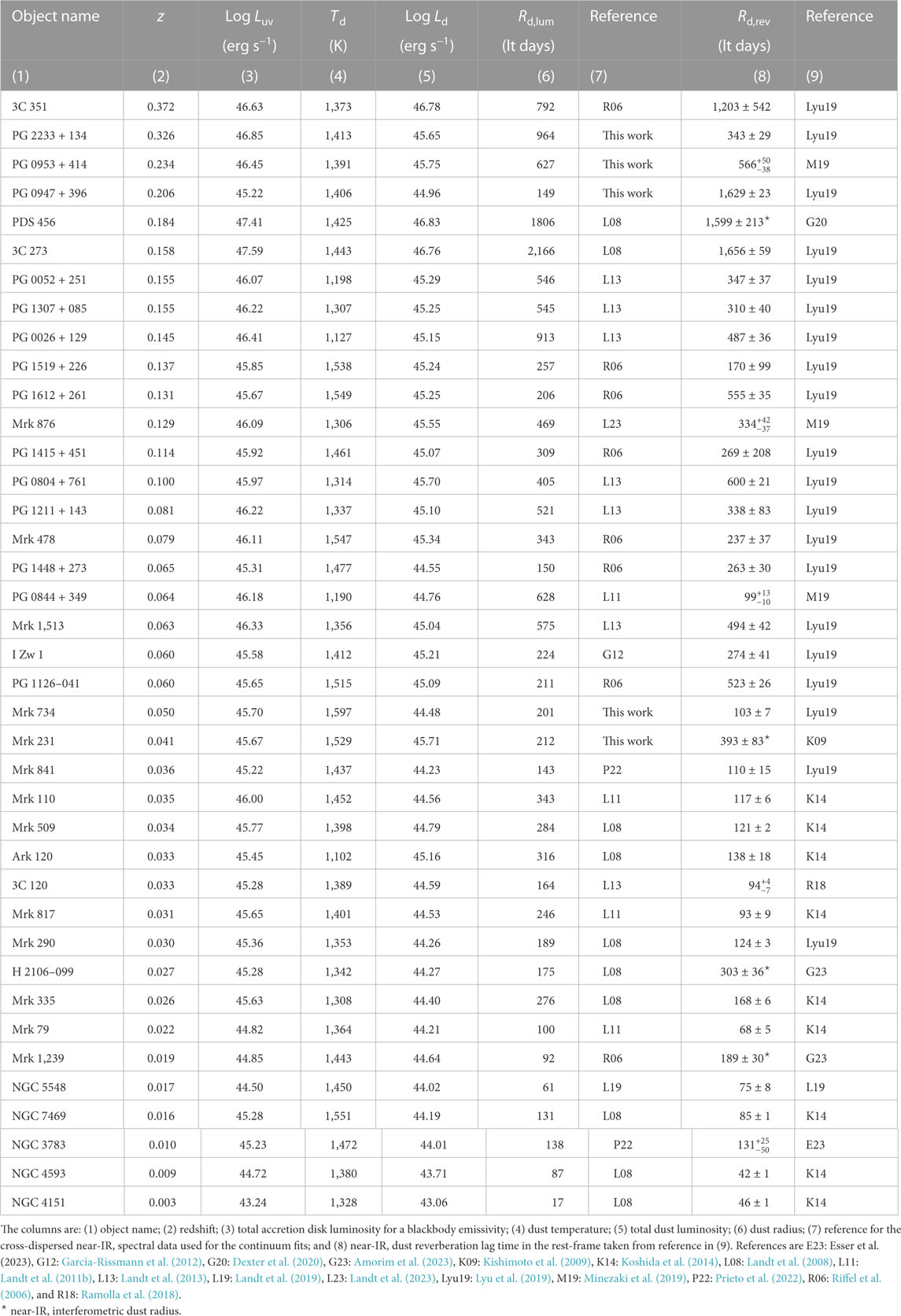- Department of Physics, Centre for Extragalactic Astronomy, Durham University, Durham, United Kingdom
Recent models for the inner structure of active galactic nuclei (AGN) aim at connecting the outer region of the accretion disk with the broad-line region and dusty torus through a radiatively accelerated, dusty outflow. Such an outflow not only requires the outer disk to be dusty and thus predicts disk sizes beyond the self-gravity limit but requires the presence of nuclear dust with favorable properties. Here, we investigate a large sample of type 1 AGN by near-infrared (near-IR) cross-dispersed spectroscopy with the aim to constrain the astrochemistry, location, and geometry of the nuclear hot dust region. Assuming a thermal equilibrium for optically thin dust, we derive the luminosity-based dust radius for different grain properties using our measurement of the temperature. We combine our results with independent dust radius measurements from reverberation mapping and interferometry, and show that large dust grains that can provide the necessary opacity for the outflow are ubiquitous in AGN. Using our estimates of the dust covering factor, we investigate the dust geometry using the effects of the accretion disk anisotropy. A flared disk-like structure for the hot dust is favored. Finally, we discuss the implication of our results for the dust radius-luminosity plane.
1 Introduction
A prominent feature in the multi-wavelength spectral energy distributions (SEDs) of active galactic nuclei (AGN) is strong infrared (IR) continuum emission, which originates from thermal dust radiation. The structure of the dust producing it is commonly assumed to be an optically thick toroid, which is aligned with the plane of the accretion disk. The accretion disk then provides the UV/optical photons that heat the dust. An alternative to the dusty torus was already proposed previously by Phinney (1989), namely, an extended and warped dusty disk. Such a structure is attractive since it could present a natural transition between the accretion disk and the central dust, without the stability problem of the torus (Krolik, 2007).
The extended dust structure emits over a large IR wavelength range, with the near-IR believed to be dominated by the hottest dust located closest to the central supermassive black hole. Therefore, AGN are most suitable to investigate the chemical composition and grain properties of astrophysical dust. Their UV/optical luminosities are usually high enough to heat the central dust to sublimation temperatures, a property which they have in common with protoplanetary disks around young stars. If we can observe these high temperatures,we can, in principle, constrain the chemistry since different species condense out of the gas phase in different environmental conditions. Previously, dust temperatures were measured in a handful of AGN by obtaining simultaneous photometry at several near-IR wavelengths (Clavel et al., 1989; Glass, 2004; Schnülle et al., 2013; 2015) but has only come of age with the availability of efficient near-IR cross-dispersed spectrographs. Landt et al. (2011b) and Landt et al. (2014) derived dust temperatures from such spectroscopy for the largest sample of type 1 AGN so far (
The first near-IR spectroscopic monitoring campaign of the hot dust in an AGN, namely, NGC 5548, found that a single component dominated both the mean and variable emission, with the dust response time and luminosity-based dust radius being consistent with each other if the emissivity of a pure blackbody was assumed (Landt et al., 2019). Thus, the dust grain size of the hot dust in this AGN could be constrained to relatively large values (of a few μm). From the estimated dust temperature and its variability, they concluded that the dust composition was predominantly carbonaceous and well below the sublimation threshold. The reverberation signal of the dust was then mainly due to a heating and cooling process in response to the variable UV/optical accretion disk flux irradiating it. Most importantly, the dust reverberation signal showed tentative evidence for a second hot dust component most likely associated with the accretion disk. The existence of dust in the outer regions of the accretion disk is a prerequisite for the recent models of the AGN structure proposed by Czerny et al. (2017) and Baskin and Laor (2018). These authors explain both the broad emission line region (BLR) and the dusty torus as part of the same outflow launched from the outer accretion disk by radiation pressure on dust. Since carbonaceous dust has a higher opacity than silicate dust, the former is preferred in this scenario. Most recently, Landt et al. (2023) presented results from a near-IR spectroscopic monitoring campaign on the high-luminosity AGN Mrk 876. The comparison of the mean and variable (rms) spectra clearly showed that at least two hot dust components are present in AGN, with the second component possibly originating in the accretion disk. However, contrary to the case of NGC 5548, the independent measure of the dust radius via reverberation mapping yielded a value a factor of
Given the high potential that a comparison between luminosity-based dust radii and those obtained by independent methods, e.g., by reverberation mapping, carries for revealing the astrochemistry and geometry of the hot dust in AGN, this study sets out to apply it to a large sample of AGN. In Section 2, we discuss the selection of the sample, whereas Section 3 gives details of the measurements required for the estimation of the luminosity-based dust radius. In Section 4, we discuss our main results and finally present the conclusion in Section 5.
2 Sample selection
As discussed by Landt et al. (2019, 2023), combining the assumption of a radiative equilibrium of optically thin dust, which encodes a dependence on the dust chemical species and grain size through the dust emissivity parameter (see Eq. 1), with an independent measurement of the dust radius can constrain the dust astrochemistry. Alternative dust radius measurements can be determined, e.g., the dust response time estimated by reverberation mapping or the geometric distance of the dust measured through near-IR interferometry. A promising new method is also the estimate of the location of the scattering region through optical spectropolarimetry of the BLR (Shablovinskaya et al., 2020). Therefore, this study required a sample of type 1 AGN with an optical/near-IR continuum dominated by AGN rather than the host galaxy starlight. Furthermore, the available near-IR spectrum should cover a sufficiently large wavelength range to allow for both an estimate of the accretion disk flux level and a measurement of the hot dust temperature in order to be able to calculate the luminosity-based dust radius. This requirement is usually met only by cross-dispersed near-IR spectra (Landt et al., 2011b). Finally, the type 1 AGN with available cross-dispersed near-IR spectra were required to have a published near-IR dust radius based on an alternative method. The total sample comprises 39 objects, and its properties are listed in Table 1. The independent dust radius measurement was mostly from near-IR (photometric) dust reverberation mapping campaigns covering the wavelength region of up to a few μm and, thus, sampling the SED of the hot dust, and in only 4/39 sources, the dust radius measurement was based on near-IR interferometry.
3 Luminosity-based dust radius
The calculation of the luminosity-based dust radius requires a measurement of the dust temperature and an estimate of the UV/optical (accretion disk) luminosity that heats the dust. Cross-dispersed near-IR spectra with their relatively large wavelength range cover about half the hot dust SED in low-redshift AGN and additionally a considerable part of the accretion disk spectrum. The latter is expected to be the dominant contributor to the continuum flux up to
where σ is the Stefan–Boltzmann constant and ⟨Qem⟩ is the Planck-averaged emission efficiency. We have approximated Luv with the accretion disk luminosity, as given in Table 1, and have used ⟨Qem⟩ = 1, which is appropriate for the case of a blackbody. The blackbody case is reached for grain sizes of a ≳ 0.4 μm and ≳ 2 μm for carbon and silicate dust, respectively (see Fig. 8 of Landt et al., 2019). As Landt et al. (2019, 2023) have shown, radii for dust composed of small grains (a ≲ 0.1 μm) are a factor of
4 Results and discussion
Based on two well-studied sources, namely, NGC 5548 and Mrk 876, Landt et al. (2023) have recently suggested that there are considerable similarities between the hot dust in AGN and that present in protoplanetary disks around young stars. In particular, these similarities are as follows: 1) the prevalence of large dust grain sizes, which, in protoplanetary disks, might have formed in the midplane of the disk by differential settling; 2) the presence of an ‘inner hole’ beyond the dust-free zone expected due to dust sublimation, which, in protoplanetary disks, is thought to be a cavity filled with gaseous disk material that can change its optical thickness and, thus, influence the location of the puffed-up so-called ‘wall’ or ‘inner rim’; and 3) a general temperature–radius relationship consistent with that for a dusty, flared, and passively illuminated protoplanetary disk. Here, we will test and expand on this proposition by using a sample of
4.1 Prevalence of large grains in the hot dust of AGN
As discussed in Landt et al. (2023), the assumption of dust, which is optically thick to the UV/optical radiation heating it and optically thin to its own IR radiation, allows us to constrain the astrochemistry of the dust through the dust emissivity parameter Qem (see Eq. 1) if the dust radius can be measured by an independent method. Fortunately, several such methods exist, including, e.g., the dust response time measured through reverberation mapping and a geometric dust radius measurement based on near-IR interferometry. Here, we have compiled dust radius measurements from these two independent methods for a sample of AGN with available near-IR spectra that were suitable to derive luminosity-based dust radii. Figure 1 plots the comparison between the luminosity-based dust radius and that obtained by an independent method, which was mostly near-IR photometric reverberation mapping. We note that the two dust radii are generally not contemporaneous and so could be affected by the variability effects of the irradiating luminosity, although Landt et al. (2019) argued that the hot dust radius is not set by sublimation and is probably luminosity-invariant.
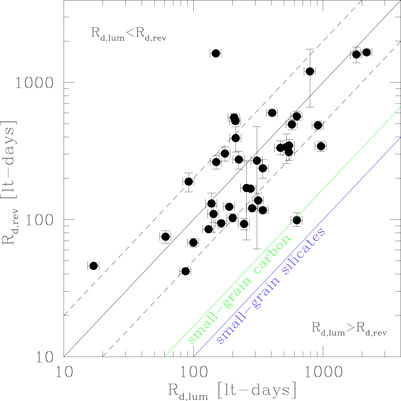
FIGURE 1. Logarithmic near-IR dust reverberation lag time versus the logarithmic luminosity-based dust radius for large dust grain sizes. The solid black line indicates the line of equality, which corresponds to the mean ratio between the two radii, whereas the dashed black lines mark the 1 σ region around it, corresponding to a factor of 2. Luminosity-based dust radii corresponding to small-grain (a ≲0.1 μm) carbon and silicate dust are expected to be larger than the values for large dust grains by a factor of
Figure 1 shows that the large majority of the data points cluster around the line of equality for a blackbody emissivity, which corresponds to the largest dust grains. The mean ratio is Rd,lum/Rrev = 1, with a dispersion around the mean of a factor of
4.2 A flared, passively illuminated (hot) dusty disk with an ‘inner hole’ in AGN
It is in general of high interest to understand the origin of the scatter in Figure 1 if it is caused by AGN physics rather than being mainly due to variability and/or measurement uncertainties. Such an investigation is particularly timely since considerable research is under way to help establish the hot dust radius as a suitable standard candle for cosmological studies using AGN (e.g., Hönig et al., 2017). A first indication that a considerable inconsistency can be present between the luminosity-based hot dust radius and that obtained by other means was found for the high-luminosity AGN Mrk 876 by Landt et al. (2023). The difference between the two values of a factor of
Figure 2 (left panel) investigates this conjecture, where we plot the total accretion disk luminosity estimated from the fits to the near-IR spectroscopy versus the ratio between the luminosity-based dust radius and the dust radius measured by reverberation mapping (or near-IR interferometry). There is clearly a trend for the dust radius ratio to increase with luminosity and so for the disk structure to be more pronounced in high-luminosity sources. The significance of a linear correlation is p = 95.5%. Figure 2 (right panel) plots the dependence of the dust radius ratio on the dust temperature. The dust temperatures reach values well above the sublimation temperature for silicates (of
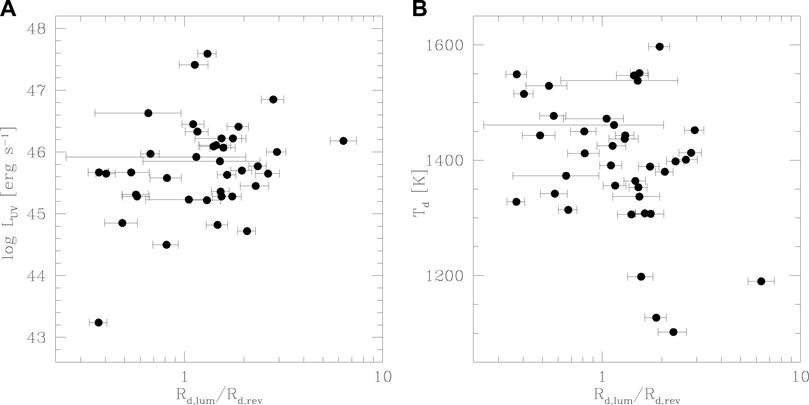
FIGURE 2. Logarithmic total accretion disk luminosity (A) and the dust temperature (B) versus the logarithm of the ratio between the luminosity-based dust radius and the dust radius measured by reverberation mapping (or near-IR interferometry).
4.3 Outer dusty edge of accretion disks in AGN
A considerably tighter relationship is present between the hot dust covering factor, defined as the ratio between the total dust luminosity and the total accretion disk luminosity, and the dust radius ratio (see Figure 3). The significance of a linear correlation is p > 99.999% for a best-fit relationship of log(Ld/LUV) = (−0.72 ± 0.05) − (0.84 ± 0.15) ⋅ log(Rd,lum/Rd,rev). This relationship could be interpreted as evidence that the ratio between the luminosity-based dust radius and that measured by reverberation mapping (or near-IR interferometry) is a suitable indicator of the dust geometry. Then, the larger this ratio, the more pronounced the flared, dusty disk structure and so the lower the expected dust covering factor. In other words, as the ratio increases, the dust geometry moves from almost circular to a short disk component with a large flare and eventually to a long disk component with a smaller flare. A sketch of this possible change in dust geometry is shown in Figure 4. Baskin and Laor (2018) investigated the geometry of a dusty, inflated accretion disk structure. Although they assumed largely varying grain sizes (spanning about two orders of magnitude), which resulted in the sublimation process occurring over a transition zone rather than at a single location, the scale height of this geometry could be related to the change in dust geometry proposed here. In their model, the disk height is set by the balance between the effects of gravity and radiation pressure, and depends only on the accretion rate and the opacity of the material (see their eq. 22). Therefore, it predicts that more luminous AGN have higher dust covering factors, which is contrary to the observed relationship presented in Figure 2.
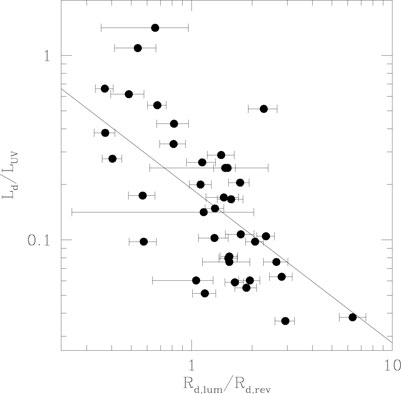
FIGURE 3. Logarithmic hot dust covering factor versus the logarithm of the ratio between the luminosity-based dust radius and the dust radius measured by reverberation mapping (or near-IR interferometry). The best-fit relationship is shown as the black solid line. See text for more details.
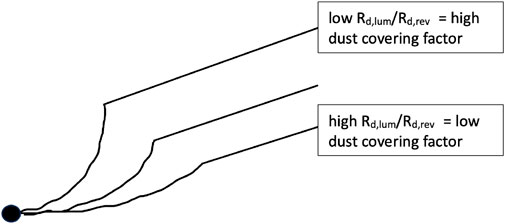
FIGURE 4. Sketch of a possible change in the dust geometry as the ratio between the luminosity-based dust radius and the dust radius measured by reverberation mapping (or near-IR interferometry) increases and thus the dust covering factor decreases.
Recently, Landt et al. (2023) presented the comparison of the mean and variable (rms) spectrum in the high-luminosity AGN Mrk 876, which showed clearly that at least two hot dust components are present in AGN. They found that the total dust emission was dominated (at the
5 Conclusion
This study used a sample of
1) It could be shown that luminosity-based dust radii obtained with the assumption of a blackbody emissivity were consistent within a factor of
2) We found a tight relationship between the dust covering factor and the ratio between the luminosity-based dust radius and the dust radius measured by reverberation mapping (or near-IR interferometry). This new relationship can be understood if one assumes that the dust radius ratio is a suitable indicator of the dust geometry and that hot dust is present in the accretion disk in addition to that assembled in a flared, dusty disk, as proposed by Landt et al. (2023).
3) The effects of the anisotropy of the accretion disk illumination might be different for low- and high-luminosity AGN, as suggested by the flattening of the slope at high luminosities in the dust radius-luminosity plane of Minezaki et al. (2019). We find a trend that the dust radius ratio increases with AGN luminosity, indicating a change in dust geometry whereby the disk structure becomes more pronounced in the high-luminosity AGN.
Data availability statement
The raw data supporting the conclusion of this article will be made available by the authors, without undue reservation.
Author contributions
HL: data curation, formal analysis, and writing-original draft.
Acknowledgments
HL acknowledges a Daphne Jackson Fellowship sponsored by the Science and Technology Facilities Council (STFC), United Kingdom, and support from STFC grants (ST/P000541/1, ST/T000244/1, and ST/X001075/1).
Conflict of interest
The author declares that the research was conducted in the absence of any commercial or financial relationships that could be construed as a potential conflict of interest.
Publisher’s note
All claims expressed in this article are solely those of the authors and do not necessarily represent those of their affiliated organizations, or those of the publisher, the editors, and the reviewers. Any product that may be evaluated in this article, or claim that may be made by its manufacturer, is not guaranteed or endorsed by the publisher.
References
Amorim, A., Bourdarot, G., Brandner, W., Cao, Y., Clénet, Y., Davies, R., et al. (2023). Toward measuring supermassive black hole masses with interferometric observations of the dust continuum. A&A 669, A14. doi:10.1051/0004-6361/202244655
Baskin, A., and Laor, A. (2018). Dust inflated accretion disc as the origin of the broad line region in active galactic nuclei. MNRAS 474, 1970–1994. doi:10.1093/mnras/stx2850
Bentz, M. C., and Katz, S. (2015). The AGN black hole mass database. PASP 127, 67–73. doi:10.1086/679601
Clavel, J., Wamsteker, W., and Glass, I. S. (1989). Hot dust on the outskirts of the broad-line region in Fairall 9. ApJ 337, 236–250. doi:10.1086/167100
Czerny, B., Li, Y.-R., Hryniewicz, K., Panda, S., Wildy, C., Sniegowska, M., et al. (2017). Failed radiatively accelerated dusty outflow model of the broad line region in active galactic nuclei. I. Analytical solution. ApJ 846, 154. doi:10.3847/1538-4357/aa8810
Dexter, J., Shangguan, J., Hönig, S., Kishimoto, M., Lutz, D., Davies, R., et al. (2020). The resolved size and structure of hot dust in the immediate vicinity of AGN. A&A 635, A92. doi:10.1051/0004-6361/201936767
Garcia-Rissmann, A., Rodríguez-Ardila, A., Sigut, T. A. A., and Pradhan, A. K. (2012). A near-infrared template derived from I zw 1 for the Fe II emission in active galaxies. ApJ 751, 7. doi:10.1088/0004-637X/751/1/7
Glass, I. S. (2004). Long-term infrared photometry of Seyferts. MNRAS 350, 1049–1066. doi:10.1111/j.1365-2966.2004.07712.x
Hönig, S. F., Watson, D., Kishimoto, M., Gandhi, P., Goad, M., Horne, K., et al. (2017). Cosmology with AGN dust time lags-simulating the new VEILS survey. MNRAS 464, 1693–1703. doi:10.1093/mnras/stw2484
Kawaguchi, T., and Mori, M. (2011). Near-infrared reverberation by dusty clumpy tori in active galactic nuclei. ApJ 737, 105. doi:10.1088/0004-637X/737/2/105
Kawaguchi, T., and Mori, M. (2010). Orientation effects on the inner region of dusty torus of active galactic nuclei. ApJL 724, L183–L187. doi:10.1088/2041-8205/724/2/L183
Kishimoto, M., Hönig, S. F., Antonucci, R., Kotani, T., Barvainis, R., Tristram, K. R. W., et al. (2009). Exploring the inner region of type 1 AGNs with the Keck interferometer. A&A 507, L57–L60. doi:10.1051/0004-6361/200913512
Koshida, S., Minezaki, T., Yoshii, Y., Kobayashi, Y., Sakata, Y., Sugawara, S., et al. (2014). Reverberation measurements of the inner radius of the dust torus in 17 seyfert galaxies. ApJ 788, 159. doi:10.1088/0004-637X/788/2/159
Krolik, J. H. (2007). AGN obscuring tori supported by infrared radiation pressure. ApJ 661, 52–59. doi:10.1086/515432
Landt, H., Bentz, M. C., Peterson, B. M., Elvis, M., Ward, M. J., Korista, K. T., et al. (2011a). The near-infrared radius-luminosity relationship for active galactic nuclei. MNRAS 413, L106–L109. doi:10.1111/j.1745-3933.2011.01047.x
Landt, H., Bentz, M. C., Ward, M. J., Elvis, M., Peterson, B. M., Korista, K. T., et al. (2008). The near-infrared broad emission line region of active galactic nuclei. I. the observations. ApJS 174, 282–312. doi:10.1086/522373
Landt, H., Elvis, M., Ward, M. J., Bentz, M. C., Korista, K. T., and Karovska, M. (2011b). The near-infrared broad emission line region of active galactic nuclei. II. the 1-μm continuum. MNRAS 414, 218–240. doi:10.1111/j.1365-2966.2011.18383.x
Landt, H., Mitchell, J. A. J., Ward, M. J., Mercatoris, P., Pott, J.-U., Horne, K., et al. (2023). A complex dust morphology in the high-luminosity AGN Mrk 876. ApJ 945, 62. doi:10.3847/1538-4357/acb92d
Landt, H., Ward, M. J., Elvis, M., and Karovska, M. (2014). Constraints on the outer radius of the broad emission line region of active galactic nuclei. MNRAS 439, 1051–1062. doi:10.1093/mnras/stu031
Landt, H., Ward, M. J., Kynoch, D., Packham, C., Ferland, G. J., Lawrence, A., et al. (2019). The first spectroscopic dust reverberation programme on active galactic nuclei: the torus in NGC 5548. MNRAS 489, 1572–1589. doi:10.1093/mnras/stz2212
Landt, H., Ward, M. J., Peterson, B. M., Bentz, M. C., Elvis, M., Korista, K. T., et al. (2013). A near-infrared relationship for estimating black hole masses in active galactic nuclei. MNRAS 432, 113–126. doi:10.1093/mnras/stt421
Lyu, J., Rieke, G. H., and Smith, P. S. (2019). Mid-IR variability and dust reverberation mapping of low-z Quasars. I. Data, methods, and basic results. ApJ 886, 33. doi:10.3847/1538-4357/ab481d
Minezaki, T., Yoshii, Y., Kobayashi, Y., Sugawara, S., Sakata, Y., Enya, K., et al. (2019). Reverberation measurements of the inner radii of the dust tori in Quasars. ApJ 886, 150. doi:10.3847/1538-4357/ab4f7b
Monnier, J. D., Millan-Gabet, R., Billmeier, R., Akeson, R. L., Wallace, D., Berger, J. P., et al. (2005). The near-infrared size-luminosity relations for herbig ae/Be disks. ApJ 624, 832–840. doi:10.1086/429266
Mor, R., Netzer, H., and Elitzur, M. (2009). Dusty structure around type-I active galactic nuclei: clumpy torus narrow-line region and near-nucleus hot dust. ApJ 705, 298–313. doi:10.1088/0004-637X/705/1/298
Phinney, E. S. (1989). “Dusty disks and the infrared emission from AGN,”. Theory of accretion disks. Editor F. Meyer (of NATO Advanced Study Institute ASI Series C), 290, 457.
Prieto, A., Rodríguez-Ardila, A., Panda, S., and Marinello, M. (2022). A novel black hole mass scaling relation based on coronal gas, and its dependence with the accretion disc. MNRAS 510, 1010–1030. doi:10.1093/mnras/stab3414
Ramolla, M., Haas, M., Westhues, C., Pozo Nuñez, F., Sobrino Figaredo, C., Blex, J., et al. (2018). Simultaneous Hα and dust reverberation mapping of 3C 120: testing the bowl-shaped torus geometry. A&A 620, A137. doi:10.1051/0004-6361/201732081
Riffel, R., Rodríguez-Ardila, A., and Pastoriza, M. G. (2006). A 0.8-2.4 mum spectral atlas of active galactic nuclei. A&A 457, 61–70. doi:10.1051/0004-6361:20065291
Salpeter, E. E. (1977). Formation and destruction of dust grains. ARA&A 15, 267–293. doi:10.1146/annurev.aa.15.090177.001411
Schnülle, K., Pott, J.-U., Rix, H.-W., Decarli, R., Peterson, B. M., and Vacca, W. (2013). Dust physics in the nucleus of NGC 4151. A&A 557, L13. doi:10.1051/0004-6361/201321802
Schnülle, K., Pott, J.-U., Rix, H.-W., Peterson, B. M., De Rosa, G., and Shappee, B. (2015). Monitoring the temperature and reverberation delay of the circumnuclear hot dust in NGC 4151. A&A 578, A57. doi:10.1051/0004-6361/201525733
Shablovinskaya, E. S., Afanasiev, V. L., and Popović, L. č. (2020). Measuring the AGN sublimation radius with a new approach: reverberation mapping of broad line polarization. ApJ 892, 118. doi:10.3847/1538-4357/ab7849
Keywords: active galactic nuclei, quasars, dust continuum emission, dust physics, near-infrared astronomy
Citation: Landt H (2023) The outer dusty edge of accretion disks in active galactic nuclei. Front. Astron. Space Sci. 10:1256088. doi: 10.3389/fspas.2023.1256088
Received: 10 July 2023; Accepted: 05 September 2023;
Published: 25 September 2023.
Edited by:
Paola Marziani, Osservatorio Astronomico di Padova (INAF), ItalyReviewed by:
Andjelka Branislav Kovacevic, University of Belgrade, SerbiaMarko Stalevski, Astronomical Observatory, Serbia
Elena Shablovinskaya, Diego Portales University, Chile
Copyright © 2023 Landt. This is an open-access article distributed under the terms of the Creative Commons Attribution License (CC BY). The use, distribution or reproduction in other forums is permitted, provided the original author(s) and the copyright owner(s) are credited and that the original publication in this journal is cited, in accordance with accepted academic practice. No use, distribution or reproduction is permitted which does not comply with these terms.
*Correspondence: Hermine Landt, aGVybWluZS5sYW5kdEBkdXJoYW0uYWMudWs=
 Hermine Landt
Hermine Landt